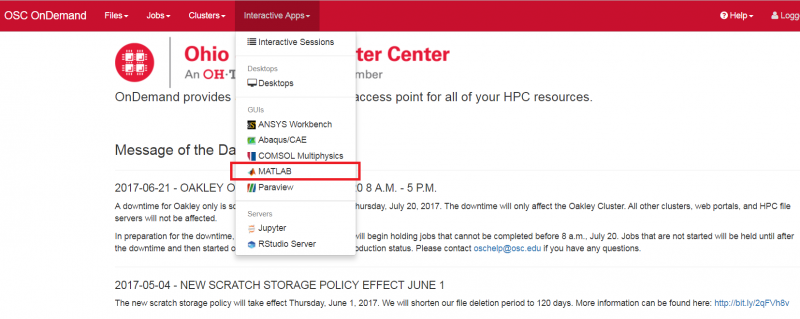VirtualGL
VirtualGL allows OpenGL applications to run with 3D hardware accerlation.
Availability & Restrictions
Versions
The following versions of VirtualGL are available on OSC clusters:
VirtualGL allows OpenGL applications to run with 3D hardware accerlation.
The following versions of VirtualGL are available on OSC clusters:
From julialang.org:
"Julia is a high-level, high-performance dynamic programming language for numerical computing. It provides a sophisticated compiler, distributed parallel execution, numerical accuracy, and an extensive mathematical function library. Julia’s Base library, largely written in Julia itself, also integrates mature, best-of-breed open source C and Fortran libraries for linear algebra, random number generation, signal processing, and string processing. In addition, the Julia developer community is contributing a number of external packages through Julia’s built-in package manager at a rapid pace. IJulia, a collaboration between the Jupyter and Julia communities, provides a powerful browser-based graphical notebook interface to Julia."
MATLAB allows matrix manipulations, plotting of functions and data, implementation of algorithms, creation of user interfaces, and interfacing with programs written in other languages, including C, C++, C#, Java, Fortran and Python.
All the desktop apps can be found within the 'Interactive Apps' dropdown in our OnDemand web portal as shown in the image below:

RStudio is an integrated development environment (IDE) for R. It includes a console, syntax-highlighting editor that supports direct code execution, as well as tools for plotting, history, debugging and workspace management.
All the desktop apps can be found within the 'Desktop Apps' dropdown in our OnDemand web portal as shown in the image below:

The OSC GPU Computing environment.
OSC OnDemand provides access to applications on compute nodes through the batch system, without the hassle or performance problems associated with X11 forwarding. To access one, please select an application under "Interactive HPC" from the "Desktop Apps" menu. For more information on each product, please go to its page provided below.
OSC has several different file systems where you can create files and directories. The characteristics of those systems and the policies associated with them determine their suitability for any particular purpose. This section describes the characteristics and policies that you should take into consideration in selecting a file system to use.
The various file systems are described in subsequent sections.
This HOWTO will demonstrate how to lower ones' disk space usage. The following procedures can be applied to all of OSC's file systems.
We recommend users regularly check their data usage and clean out old data that is no longer needed.
Users who need assistance lowering their data usage can contact OSC Help.
Darshan is a lightweight "scalable HPC I/O characterization tool
The following versions of Darshan are available on OSC clusters:
Apache Spark is an open source cluster-computing framework originally developed in the AMPLab at University of California, Berkeley but was later donated to the Apache Software Foundation where it remains today. In contrast to Hadoop's disk-based analytics paradigm, Spark has multi-stage in-memory analytics. Spark can run programs up-to 100x faster than Hadoop’s MapReduce in memory or 10x faster on disk. Spark support applications written in python, java, scala and R.